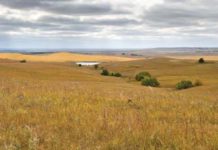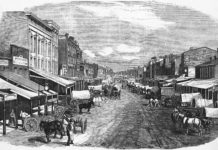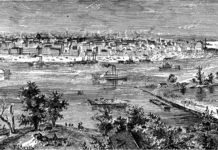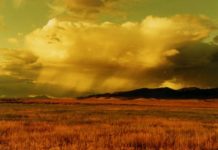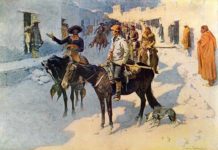Until the mid-1840s about the only protection for westward bound travelers was Fort Leavenworth in present-day Kansas. Leavenworth’s major function, at that time, was to protect travelers on Santa Fe Trail during the highly profitable trade with New Mexico. The west was a big, wide-open land that provided little protection for white adventurers. Further west, towards the Rocky Mountains, there were some establishments. These mostly had been erected by various mountain men and fur trading companies and whose major intent was to act as trading post such as Fort Hall in present-day Idaho and Fort Bridger in present-day Wyoming.
In time folks began to leave the east and head west, looking for gold or a new plot of land to sink their plow into. At the time, Fort Laramie, located many treacherous miles away in Wyoming, became the closest thing to civilization once these stouthearted people left the comforts of Saint Louis, Missouri. At first Fort Laramie served the multitude of travelers along the Oregon Trail. Eventually it also lent its services to those traveling the California and Mormon Trails, all headed west for an increasing variety of reasons. In the years following 1849 and the discovery of gold in California, Laramie became a noted milestone of the westward movement.
Previously, in 1847, Fort Kearny had been built in Nebraska and was also intended to protect the Oregon Trail. This Nebraska fort should not be confused, however, with Fort Phil Kearney, Wyoming, built in 1866, to protect white travelers along the Bozeman Trail. This later famous fort became the source of many colorful and bloody conflicts between whites and Indians until Red Cloud burnt it to the ground.
The Plains Indians were at first amazed, then enraged, by the number of whites that crossed the plains in those early years. The Indians’ anger increased as the migration of the buffalo was interrupted and prairie grasses were trampled and depleted by oxen and mules. Then cholera, smallpox, and many other white mans diseases came west with the wagon trains and made their deadly introduction to the Indians.
Due to the increase of white travelers along the Oregon Trail, in 1851, the government negotiated a treaty with the Plains Indians in order to clear the westward routes of “marauding savages.” Some ten thousand Sioux, Crow, Cheyenne and Arapahos gathered near Fort Laramie and signed this treaty, agreeing to relocate to reservations.
Previously, due to the outcome of the war with Mexico, the United States had gained rights to a considerable area of land. In addition, because of the agreement with Great Britain over the boundaries of Oregon, the United States had also gained additional vast areas of land. The possibilities for settlement were now seemingly unlimited. But safe routes had to be established to induce settlers to move to these new areas. Therefore, the treaty of 1851 also required that the Indians give unrestricted traveling rights to whites on the westward trails and that the government would also be allowed to establish forts along these routes.
When these Indians signed this treaty the payment to them was to be $50,000 each year for fifty years which, considering the multitude of persons involved, figured out to be about $5.00 per Indian per year. Sometime later the government broke this treaty agreement by reducing the total year-span to fifteen years instead of fifty. Somehow, in the hustle and bustle of changing this treaty, the government sort of overlooked consulting the Indians involved about this change. Of course this greatly upset the Indians who proceeded to make their opinion known’in their own way. The whole “misunderstanding” made it necessary for the military to step in and, naturally, these horse-riding boys in blue needed a place to hang their hats. Thus, more forts were need across the plains.
A situation that continued to be a source of grievance with the Indians was that those Indians who did sign treaties could only speak for the members of their own individual bands. No one signer could act as a representative of an entire Indian nation or tribe, a concept that white military and government leaders never grasped, or refused to admit understanding. And not all of the chiefs of these bands signed. Therefore the nonsigners did not consider themselves or their group liable under the terms of the treaty. This, also, was a situation that the whites never understood and it constantly caused upheavals.
This introduction into American Western Forts has only hit upon a few of the numerous forts and military and supply camps that, in time, stretched across the west. The related articles to come will bring to life a vast collection of incidents and the forts involved.



